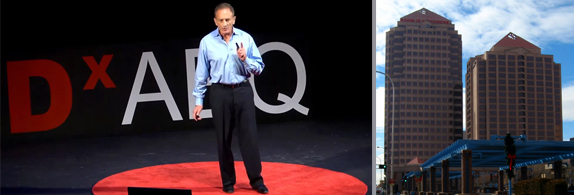
Working to overcome a familiar sense of dejection after the city elections, this month, I was browsing the internet and came across the disappointing September 30th KNME mayoral debate and then, quite by accident, found myself watching a TEDxABQ on YouTube from October 14, 2012 with New Mexico real estate developer Gary Goodman. What a glaring contrast.
Despite the good intentions of all concerned, after the city election Albuquerque is once again left with a government has no guiding principles, no strategic goals for the future, no set of tactics to achieve them, and certainly no Big Idea to drive its future.
Gene Grant, leading KNME’s debate, asked important questions about water, and I still think defeated candidate Pete Dinelli had the best answers, while the mayor was protecting the status quo. But one could never confuse the candidates with visionaries. Especially in contrast with Gary Goodman’s polished ideas.
I’d really never heard of Goodman before, except in the context of remaking the old Hilton Hotel downtown into Hotel Andaluz and working to redevelop the long abandoned Winrock Mall to be a showcase for contemporary sustainable design. I’m always suspicious of the idea of “sustainability” because it generally means, in my mind, sustaining what already doesn’t work.
But after listening to Goodman’s TED talk I’m suddenly energized in a way I haven’t been in long while. He advocates for a focused New Mexico and Albuquerque “big idea,” one major focus that has many variables. And he picked “natural resource management.” That doesn’t sound very exciting on the surface of it, but when you think a little further it is the right idea for our state and our times. Many of us have thought so, but not with Goodman’s eloquence.
Goodman lays out New Mexico’s economic troubles since the 2008 recession, citing all the states around us that do much better than we do attracting jobs. He predicts, tellingly, that with the sequester in place, government jobs, our former bread and butter, will be disappearing.
We need a “robust private sector,” he says, that distinguishes us from other places, something that we can make our own. Smaller places like Albuquerque, and big states with small populations like New Mexico, can’t compete with places that have the size to be most things to most people. We have to focus.
He cites many smaller places around the country – principally Raleigh, North Carolina and the region’s “research triangle,” with its huge concentration of brain power and vast capital, as one of the success stories of focusing on a “big idea.”
What inspired me the most was Goodman’s recognition of New Mexico’s existing talent. Not only do we have national labs that could act as innovation incubators in natural resource management, we have a research oriented university in Albuquerque and a resource oriented university in Las Cruces. When you combine existing talent with New Mexico’s vast natural resources, including renewable energy and fossil fuels, we have the ingredients we need to become a world leader in creating more environmentally “friendly” ways of making use of the earth’s bounty.
And because the United Nations has predicted that two-thirds of the earth’s surface is becoming water stressed because of climate change, he asked rhetorically “Is there a bigger growth industry in the world” than water management?
And here we are in a water stressed state with public officials doing their best to downplay problems instead of looking the future in the eye and trying to find a way to turn troubles to our advantage and do some good for the world in the process.
The big ideas work, if they are in sync with their times, because they focus efforts and create stimulating environments. Innovators like to cluster because of shared infrastructure and sources of venture capital. And big ideas, Goodman says, attract industry clusters and eventually become “job magnets.”
Imagine what might happen if the University of New Mexico would create a school for natural resource management as an academic anchor for such a big idea. It could put Albuquerque and New Mexico at the center of “the growth industry of the 21st century.”
Some might argue that a big idea like that might fall into the hands of big money resource exploiters who would pay token homage to sustainability and ecological common sense while continuing their polluting ways. But a cluster of industries could work against exploitation, seeing old practices for what they are --bad for business, bad for people, and bad for the future. No one can survive, and certainly no business can prosper, in a severely degraded, water stressed environment, and filled with legacy pollution and suffering from chaotic explosions of devastating weather events.
Let’s focus ourselves as a community to think together about what it takes to create a healthy environment and healthy economic future for us all. Albuquerque and New Mexico could become a center for environmental sanity and the generation of pragmatic solutions to the water and pollution crises just ahead. Goodman’s TED talk is the perfect place to start.
(ABQ skyline photo by Ken Lund)



Responses to “What’s Happened to Albuquerque? Part 10: Gary Goodman and the Big Idea”